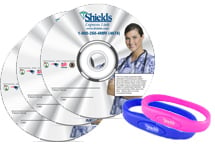Yes! Not only should you keep them but they belong to you.
As a physician, one of the first things we need to know is what happened to you before you walked into our office. What’s your story? That’s why we ask you so many questions! Think of yourself as the teacher and the physician as the student – you want to make sure the student knows enough to make the right decisions and pass (or in this case "recommend") the test . This is health care 101!
If you could simply hand over your medical history in a neat and complete package it would not only make the process easier but, most importantly, it would result in better care for you and avoid repetitive medical testing.
But how do you gather your MRI & CT images? And how do you control who will see them?
 You already know your health record belongs to you and the most common way to get your images is on a CD. Most imaging sites will give you a CD at the time of your test. Just ask! [best to ask before the test so the CD can be made before you leave the facility.] Some places have a policy or set of procedures and ways to comply with HIPPA (a health care law meant to protect patient privacy and the topic of another post!) that they will not give you the images until they have been interpreted or lots of forms to complete before they will release the information – if this is the case remember to follow-up and request that the facility mail you the CD. My personal preference is to take my images with me when I leave a hospital or medical center..
You already know your health record belongs to you and the most common way to get your images is on a CD. Most imaging sites will give you a CD at the time of your test. Just ask! [best to ask before the test so the CD can be made before you leave the facility.] Some places have a policy or set of procedures and ways to comply with HIPPA (a health care law meant to protect patient privacy and the topic of another post!) that they will not give you the images until they have been interpreted or lots of forms to complete before they will release the information – if this is the case remember to follow-up and request that the facility mail you the CD. My personal preference is to take my images with me when I leave a hospital or medical center..
You are investing a good deal of time gathering this information. I know because I have too. Please persevere - an electronic copy of each and every imaging test that you or a family member has had is important for on-going medical care. Think of it as your own library of images. Whenever you need to have another test you can “loan” the record (or a copy) of your previous MRI / CT studies to a physician , they can copy what they need, and give you the original back.
Putting your images on a USB memory stick is another option. At Shields we call it a “Scan Band”. It’s a bracelet which contains a memory chip large enough to hold all the scans you’ve had here (unless you’ve had an awful lot of scans!) as well as the reports. It also has a program that can display the pictures on a PC. You’ve “got it all” so to speak. You can ask for one from our medical records department and hand it to your health care provider when they need it. Key features of the scan band are:
1. Portability - You have it with you wherever you are, whenever you need it!
2. Control -- You manage who gets it. If they shouldn’t be seeing your pictures, don’t hand them the bracelet!
3. Flexibility – You can add information to the scan band to create a complete medical history . You generally cannot do this with CDs.
Whether you get your pictures on CD or on a USB device like the Shields Scan Band, you are taking important steps to assemble your personal medical history and image library and taking control of your heath information.
Now, this is just a start – in a perfect world you would also have a copy of all your medical records at your fingertips. In France, for example, residents have it all on a card which can be handed to any health professional you visit. In the US, we aren’t there yet but you can begin by gathering your images into one library controlled by you. In future posts we’ll have a chance to take a look at some of the things you might want to consider doing to secure and back-up your personal image library as well as build a personal copy of all your medical records.
Remember– it’s your medical information & your medical history ~ ask for a copy and hold onto it for future health care needs.



